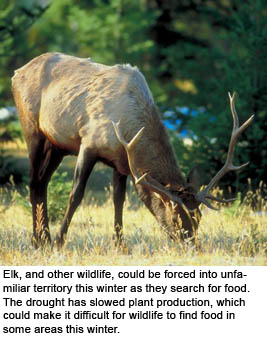Drought Causes Winter Risks for Wildlife
Drought Causes Winter Risks for Wildlife

With the drought lingering into fall, wildlife could be forced to venture onto private property, searching for food and warmth as winter nears. Without an adequate food supply, animals must move to another area to get necessary nutrients or be unprepared when winter begins.
“If plants don’t produce enough food because of drought conditions, wildlife can go into the winter without the proper conditioning or fat reserves,” said Tom Barnes, wildlife specialist for the University of Kentucky Cooperative Extension Service. “This could cause them to not reproduce as well.”
With no other choice, animals must search for food alternatives, which could lead them into people’s backyards. Landowners can take precautions to keep wildlife away from their homes. One way to keep wild animals away is not to give them easy access to food by leaving out dog or cat food overnight. Make sure all garbage containers are covered, and keep doors and windows secure. If an animal comes onto personal property, don’t feed it, Barnes said.
“When people feed an animal, it encourages them to get close and familiar with humans, which creates the potential for future problems,” Barnes said.
Not only does feeding wildlife cause potential problems for humans, but it could endanger the animals. Some corn contains high levels of the toxic chemical aflatoxin, which can be potentially hazardous if ingested by wildlife, Barnes said.
In addition to increased appearances on private property, wildlife may be seen more on the roadways this fall. Motorists should be weary of animals venturing onto highways because wildlife may be attracted to roadway medians. The runoff from the small amount of rain in the area has caused many medians to stay lush and green, Barnes said. This can look extremely appealing to an animal that has no other food source but dried up forage.
The effects of the drought on aquatic life may not be as visible to humans, but risks associated with low water levels do exist. Kentucky State University Extension Specialist for Aquaculture Bob Durborow said when water levels are low, fish are forced closer together.
“The water gets hotter and oxygen can’t stay in the water as long,” he said. “Fish can be stressed severely or suffocate.”
In constrained quarters, fish don’t have a lot of room to release waste and the chance for fish to transmit diseases to one another increases, he said.
“If 20 percent of the fish have a mild infection and they are in close quarters, 100 percent of the fish population could get sick,” Durborow said.
He said shallow water areas are conducive to algae and weeds, which can clog ponds. Propellers with outboard motors and fishhooks can get easily tangled in algae and weeds.
“It’s just a mess,” he said. “I’ve seen a lot of weed problems and bare, earthen banks along the edges of ponds around the state.”
Not only do weeds and algae increase, but the drought also provides ideal conditions for organisms such as midges to flourish. Midges can carry a virus that causes epizootic hemorrhage disease or bluetongue in wildlife. The virus is transmitted when a midge bites an infected animal and then bites an uninfected animal. While the diseases can be fatal to wildlife, they do not affect humans.
“There have been 76 counties in the state to report animals that have died from EHD or bluetongue,” Barnes said. “This is the worst outbreak the state has had in three to four decades. The drought only makes it worse.”
Another effect of the drought on wildlife is the increase in the potential of forest fires. The fall fire season began Oct. 1 and won’t end until Dec. 15. Kentucky Gov. Ernie Fletcher issued a ban on all outdoor burning Oct. 4 because of the extreme drought conditions.
“October typically has less rain than other months. With no rain this summer, it is extremely dry,” said Douglas McLaren, UK extension forestry specialist.
Falling leaves are a huge fuel source for fires, but with the drought conditions the state is experiencing, grass could easily catch fire, he said. McLaren emphasized that any person who starts a fire either directly or indirectly, is responsible for all the suppression cost of the fire, including labor and equipment.
If a fire does occur, typically wildlife will get out of the way and venture into unfamiliar areas, including private property and roadways, McLaren said.